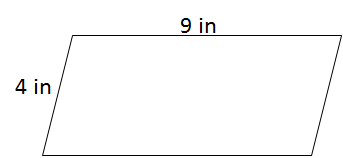Parallelograms - ISEE Middle Level Math
Card 0 of 10
Find the area:

Find the area:

The area of a parallelogram can be determined using the following equation:

Therefore,

The area of a parallelogram can be determined using the following equation:
Therefore,
Compare your answer with the correct one above
You can solve the area of a parallelogram when you know the lengths of each of the sides. True or False?
You can solve the area of a parallelogram when you know the lengths of each of the sides. True or False?
The area of a parallelogram is found by computing  . In this situation, you would have the base which is the bottom side but you would not have the height measurement. Since you would not be able to solve for the area with just the side lengths, the statement is
. In this situation, you would have the base which is the bottom side but you would not have the height measurement. Since you would not be able to solve for the area with just the side lengths, the statement is  .
.
The area of a parallelogram is found by computing 

Compare your answer with the correct one above
If a parallelogram has side lengths of  and
and  , what is the area?
, what is the area?
If a parallelogram has side lengths of 

To find the area of a parallelogram, you use the formula,
 .
.
Since the height in this problem is not known, you cannot solve for area.
To find the area of a parallelogram, you use the formula,

Since the height in this problem is not known, you cannot solve for area.
Compare your answer with the correct one above
Find the area of a parallelogram with a base of 6 inches and a height of 9 inches.
Find the area of a parallelogram with a base of 6 inches and a height of 9 inches.
To find the area of a parallelogram, we will use the following formula:

where b is the base and h is the height of the parallelogram.
Now, we know the base has a length of 6 inches. We also know it has a height of 9 inches. Knowing this, we can substitute into the formula. We get


To find the area of a parallelogram, we will use the following formula:
where b is the base and h is the height of the parallelogram.
Now, we know the base has a length of 6 inches. We also know it has a height of 9 inches. Knowing this, we can substitute into the formula. We get
Compare your answer with the correct one above
Find the area of the parallelogram with a base length of 6 and a height of 15.
Find the area of the parallelogram with a base length of 6 and a height of 15.
Write the area formula of a parallelogram.

Substitute the dimensions into the formula.

The answer is: 
Write the area formula of a parallelogram.
Substitute the dimensions into the formula.
The answer is:
Compare your answer with the correct one above

Note: Figure NOT drawn to scale.
 , where
, where  and
and  represent side lengths of the parallelogram and
represent side lengths of the parallelogram and  represents the height.
represents the height.
Find the perimeter of the parallelogram in the diagram.

Note: Figure NOT drawn to scale.




Find the perimeter of the parallelogram in the diagram.
The perimeter of the parallelogram is the sum of the four side lengths - here, that formula becomes
 .
.
Note that the height  is irrelevant to the answer.
is irrelevant to the answer.
The perimeter of the parallelogram is the sum of the four side lengths - here, that formula becomes

Note that the height 
Compare your answer with the correct one above
If the perimter of a parallelogram is  and one of the sides is
and one of the sides is  , what is the other side length?
, what is the other side length?
If the perimter of a parallelogram is 

The perimeter of a parallelogram is found by adding up all four sides.
Since there are two pairs of side with equal lengths, two sides must have a length of  .
.
So the perimeter would be
 or
or  .
.
To find the value of the other side length, you would divide the remaining perimeter not include in the other sides by  .
.
So  .
.
That means the other side length would be  .
.
The perimeter of a parallelogram is found by adding up all four sides.
Since there are two pairs of side with equal lengths, two sides must have a length of 
So the perimeter would be


To find the value of the other side length, you would divide the remaining perimeter not include in the other sides by 
So 
That means the other side length would be 
Compare your answer with the correct one above
If a parallelogram has side lengths of  and
and  , what is the perimeter?
, what is the perimeter?
If a parallelogram has side lengths of 

The perimeter of a parallelogram is two times the two side lengths and add them together.

Therefore, this particular problem becomes as follows.

and

so
 .
.
The perimeter of a parallelogram is two times the two side lengths and add them together.
Therefore, this particular problem becomes as follows.
and
so

Compare your answer with the correct one above

 .
.


